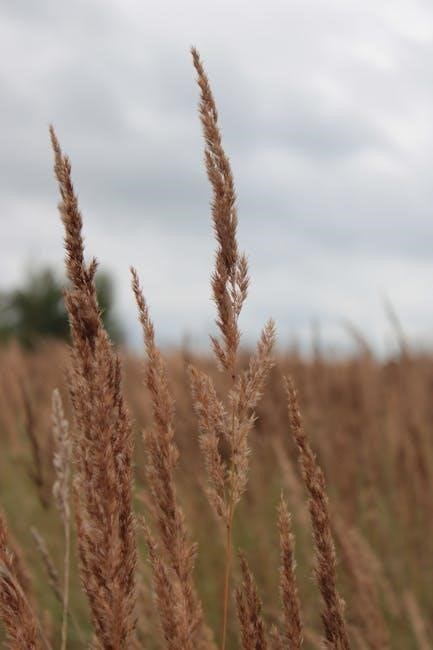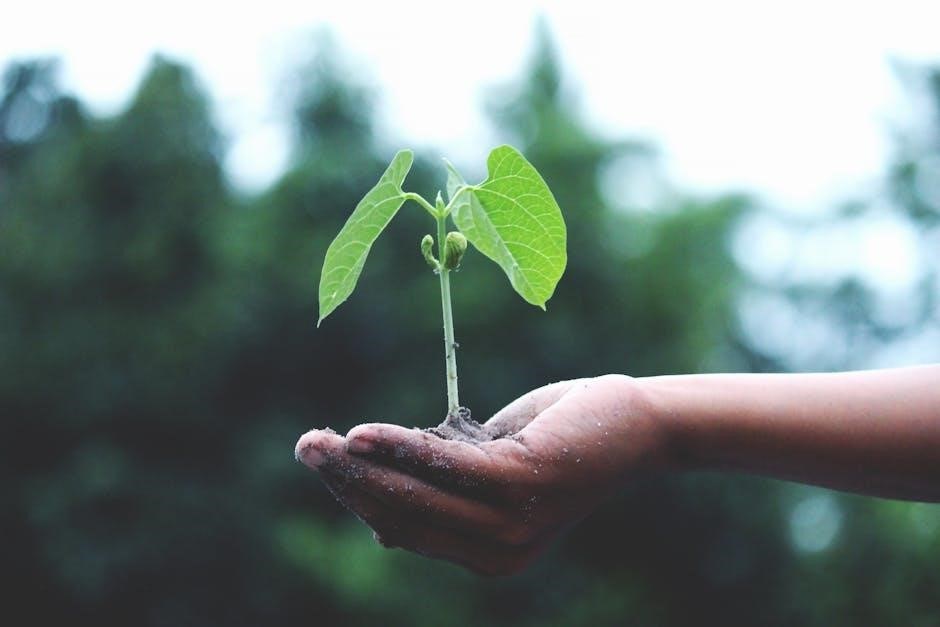Biodynamic growing guide cards offer a holistic approach to gardening, aligning planting and soil care with lunar cycles and cosmic rhythms for enhanced fertility and sustainability.
1.1 What is Biodynamic Growing?
Biodynamic growing is a holistic agricultural method that integrates spiritual and ecological principles to create a self-sustaining ecosystem. It emphasizes harmony with natural rhythms, lunar cycles, and cosmic influences, using natural preparations to enhance soil fertility and plant health. This approach goes beyond organic farming by considering the farm as a living organism, fostering biodiversity, and promoting long-term sustainability. Biodynamic growing guide cards provide practical insights and timing for planting, soil care, and pest management, helping gardeners align their practices with nature’s cycles for healthier crops and a balanced environment.
1.2 The Role of Guide Cards in Biodynamic Practices
Biodynamic growing guide cards serve as essential tools for aligning gardening activities with natural and cosmic rhythms. They provide detailed insights into lunar cycles, planting times, and the use of natural preparations to enhance soil health and plant vitality. These cards act as practical references, helping gardeners make informed decisions on when to plant, harvest, and care for their crops. By following the guidance, gardeners can optimize their practices, leading to improved soil fertility, healthier plants, and increased yields. The cards simplify biodynamic principles, making them accessible and easy to integrate into daily gardening routines for sustainable and harmonious growth.

History and Philosophy of Biodynamic Growing
Rooted in spiritual and ecological principles, biodynamic growing traces its origins to Maria Thun’s lunar research, emphasizing harmony with nature and cosmic rhythms for sustainable agriculture.
2.1 Origins and Evolution
The origins of biodynamic growing trace back to Maria Thun’s pioneering lunar research in the 1950s, which laid the foundation for understanding cosmic influences on agriculture. The Stella Natura charts, reflecting her observations, became a cornerstone for biodynamic gardeners, offering insights into planting and harvesting aligned with celestial rhythms. Over time, biodynamic growing guide cards evolved to include detailed instructions, making this spiritual and ecological approach accessible to both novices and experienced gardeners. These tools integrate ancient wisdom with practical methods, fostering a deeper connection between nature and cultivation.
2.2 Key Philosophers and Practitioners
Maria Thun, a German biodynamic farmer, pioneered lunar research starting in the 1950s, providing empirical evidence for biodynamic practices. Her work laid the foundation for tools like the Stella Natura charts, which guide gardeners in aligning planting with celestial rhythms. Rudolf Steiner, an Austrian philosopher, is credited with originating biodynamic agriculture, blending spiritual and ecological principles. These visionaries, along with modern practitioners, have shaped biodynamic growing into a global movement, inspiring gardeners to adopt holistic, nature-aligned methods through resources like biodynamic growing guide cards.
Principles of Biodynamic Growing
Biodynamic growing integrates lunar cycles, cosmic influences, and natural preparations to create a balanced ecosystem, fostering soil health and plant vitality through harmonious, nature-aligned practices.
3.1 Lunar Cycles and Planting
Biodynamic growing guide cards emphasize the importance of lunar cycles in planting, with activities timed according to moon phases. The new moon is ideal for planting, while the full moon is better for harvesting. These cards provide detailed insights into how the moon’s position influences soil and plant energy, helping gardeners synchronize their efforts with natural rhythms. By following these lunar guidelines, growers can enhance crop vitality and ensure optimal timing for tasks like sowing seeds or pruning. This alignment with celestial patterns promotes healthier growth and more abundant yields, making lunar cycles a cornerstone of biodynamic practices.
3.2 Cosmic Influences on Agriculture
Biodynamic growing guide cards highlight the profound impact of cosmic influences on agriculture, extending beyond lunar cycles to include planetary alignments. These cards often reference Moon-Saturn oppositions and other celestial events, which are believed to affect soil vitality and plant growth. By understanding these cosmic rhythms, gardeners can optimize planting, pruning, and harvesting activities. Tools like the Stella Natura chart, developed from Maria Thun’s research, provide detailed insights into these patterns. This holistic approach ensures that agricultural practices are attuned to both lunar and planetary cycles, fostering healthier plants and more resilient ecosystems. Cosmic influences are integral to biodynamic farming’s success.
3.3 Natural Preparations and Soil Health
Biodynamic growing guide cards emphasize the use of natural preparations to enhance soil health and vitality. These preparations, such as cow manure and silica-based solutions, are applied in specific ways to enrich the soil. The cards provide detailed instructions on how to create and use these preparations, ensuring optimal nutrient availability for plants. By fostering a balanced soil ecosystem, these methods promote robust plant growth and resilience. The guide cards also highlight the importance of composting and crop rotation, further supporting soil fertility and long-term agricultural sustainability. Natural preparations are a cornerstone of biodynamic farming, enhancing soil health holistically.

Benefits of Using Biodynamic Growing Guide Cards
Biodynamic growing guide cards enhance soil fertility, improve crop yields, and align gardening practices with natural rhythms, promoting sustainable and thriving ecosystems for gardeners of all levels.
4.1 Enhanced Soil Fertility
Biodynamic growing guide cards emphasize the use of natural preparations and lunar cycles to enrich soil fertility. These cards provide insights into creating nutrient-rich soil by aligning planting with cosmic rhythms, ensuring optimal nutrient absorption. By following the guide, gardeners can enhance organic matter, improve microbial activity, and promote a balanced soil ecosystem. This holistic approach fosters healthy root development and robust plant growth, resulting in more vibrant and resilient crops. The guide cards also encourage the use of compost and manure, further boosting soil health and sustainability for long-term agricultural success.
4.2 Improved Crop Yields
Biodynamic growing guide cards play a pivotal role in enhancing crop yields by aligning planting schedules with lunar cycles and cosmic influences. These cards provide detailed insights into optimal planting times, ensuring plants thrive in harmony with natural rhythms. By following the guide, gardeners can maximize photosynthesis, improve root development, and foster robust growth. The use of natural preparations further enriches soil health, leading to more abundant and nutritious harvests. This method not only boosts productivity but also ensures crops are resilient to environmental stresses, making it a reliable approach for achieving bountiful yields season after season.
4.3 Alignment with Natural Rhythms
Biodynamic growing guide cards emphasize harmony with natural cycles, guiding gardeners to plant, prune, and harvest in sync with lunar phases and cosmic influences. By aligning activities with the moon’s rhythms, gardeners can optimize growth, reduce plant stress, and enhance biodiversity. These cards provide daily insights, ensuring tasks are timed to maximize productivity and vitality. This holistic approach fosters a deeper connection with nature, promoting balanced growth and resilience in plants. The result is a gardening practice that honors the earth’s inherent rhythms, leading to healthier ecosystems and more sustainable outcomes.

How to Use Biodynamic Growing Guide Cards
Biodynamic growing guide cards provide practical steps for aligning gardening tasks with lunar cycles and natural preparations, ensuring optimal planting and soil care throughout the season.
5.1 Practical Applications in Gardening
Biodynamic growing guide cards provide clear, actionable advice for gardeners, offering insights into planting, soil preparation, and composting based on lunar cycles and cosmic influences. These cards serve as quick references for tasks like sowing seeds, transplanting, and harvesting, ensuring activities align with optimal natural rhythms. By following the guide, gardeners can enhance soil fertility, improve plant health, and boost yields. The cards also include tips on natural pest control and biodiversity promotion, making them an essential tool for sustainable and holistic gardening practices that foster a balanced ecosystem.
5.2 Integrating Guide Cards into Daily Gardening Routines
Biodynamic growing guide cards seamlessly integrate into daily gardening routines, offering practical reminders for tasks like compost preparation and planting. Gardeners begin each season by reviewing the cards to align activities with moon phases and cosmic rhythms. During daily routines, the cards serve as quick references, ensuring tasks are timed optimally. This structured approach makes biodynamic practices manageable and accessible, even for beginners. By incorporating these cards, gardeners can maintain a balanced and productive garden while fostering a deeper connection with natural cycles and rhythms.
5.3 Seasonal Planning with Guide Cards
Biodynamic growing guide cards are invaluable for seasonal planning, helping gardeners align planting, composting, and harvesting with lunar cycles and cosmic rhythms. By organizing tasks according to moon phases, gardeners can optimize growth and productivity. The cards provide clear, structured guidance, ensuring activities are timed to enhance soil health and plant vitality. This approach fosters a balanced and sustainable growing season, allowing gardeners to visualize and prepare for each phase effectively. Seasonal planning with guide cards promotes harmony with nature, leading to thriving, resilient gardens year-round.

Structure and Design of Biodynamic Growing Guide Cards
Biodynamic guide cards are designed as durable, laminated A4 sheets with vibrant illustrations, symbols, and interactive wheels, providing clear, organized guidance for gardening practices.
6.1 Features of the Guide Cards
Biodynamic growing guide cards are crafted as durable, laminated A4 sheets, featuring full-color illustrations and interactive wheels. They include detailed symbols, planting schedules, and cosmic influence indicators, providing gardeners with a holistic tool to align their practices with lunar cycles and natural rhythms. The cards are designed for easy reference, offering step-by-step instructions for soil preparation, composting, and crop rotation. Their vibrant visuals and organized layout make complex biodynamic principles accessible, ensuring gardeners can implement sustainable and regenerative methods effectively. These cards are both practical and educational, supporting gardeners in creating thriving, self-sustaining ecosystems.
6.2 Visual and Symbolic Elements
Biodynamic growing guide cards feature vibrant, detailed illustrations and symbolic representations of cosmic influences, plant traits, and natural preparations. Color-coded elements and intuitive symbols help gardeners interpret lunar cycles, planetary alignments, and soil health indicators. These visual aids simplify complex biodynamic principles, making them accessible to all skill levels. The cards’ design emphasizes clarity, ensuring gardeners can quickly identify optimal planting times, preparation methods, and pest management strategies. This visual approach fosters a deeper connection to nature’s rhythms, empowering gardeners to make informed, holistic decisions for their gardens.

The Role of Biodynamic Growing Guide Cards in Sustainability
Biodynamic growing guide cards promote sustainability by reducing synthetic inputs, enhancing biodiversity, and aligning gardening practices with natural rhythms, fostering a healthier, self-sustaining ecosystem.
7.1 Promoting Biodiversity
Biodynamic growing guide cards play a vital role in promoting biodiversity by encouraging gardeners to create balanced ecosystems. These cards provide insights into companion planting, crop rotation, and natural preparations, which foster a diverse range of plants and soil organisms. By aligning gardening practices with lunar cycles and cosmic influences, gardeners can support pollinators and beneficial insects, enhancing the overall health of their gardens. This holistic approach ensures that gardens become thriving habitats for various species, promoting ecological balance and long-term sustainability. The guide cards empower gardeners to make informed decisions that nurture biodiversity effectively.

7.2 Reducing Synthetic Inputs
Biodynamic growing guide cards emphasize the use of natural preparations and lunar cycles to minimize reliance on synthetic fertilizers and pesticides. By aligning gardening practices with cosmic rhythms, gardeners can enhance soil health and plant resilience without chemical inputs. The guide cards promote composting, herbal remedies, and biodiversity to create self-sustaining ecosystems. This approach not only reduces environmental impact but also ensures healthier plants and ecosystems. By fostering natural balance, biodynamic methods offer a sustainable alternative to conventional farming, encouraging gardeners to adopt eco-friendly practices that prioritize soil vitality and ecological harmony.

Advanced Techniques in Biodynamic Growing
Advanced techniques involve companion planting, crop rotation, and using horoscopes to optimize planting, enhancing soil health and plant vitality through cosmic alignment and natural rhythms.
8.1 Companion Planting and Crop Rotation
Companion planting and crop rotation are advanced biodynamic techniques that enhance soil health and plant diversity. Guide cards provide insights into which plants benefit from each other, deterring pests and improving growth. Crop rotation breaks pest and disease cycles, maintaining soil fertility. These methods, guided by lunar cycles, promote a balanced ecosystem. By following the cards, gardeners can optimize plant placement and timing, ensuring healthier crops and higher yields. This holistic approach aligns with biodynamic principles, fostering a sustainable and thriving garden ecosystem.
8.2 Using Horoscopes for Planting
Biodynamic growing guide cards often incorporate astrological insights, using horoscopes to align planting with celestial rhythms. These cards decode cosmic influences, helping gardeners determine optimal times for sowing and harvesting. By syncing planting activities with planetary positions, growers can enhance plant vitality and resilience. This esoteric yet practical approach ensures crops thrive in harmony with cosmic cycles, fostering a deeper connection between the gardener, soil, and universe. The cards simplify complex astrological data, making it accessible for gardeners to apply these ancient wisdoms effectively in their daily practices.

Biodynamic Growing Guide Cards vs. Traditional Organic Farming
Biodynamic growing guide cards emphasize cosmic rhythms and natural preparations, differing from traditional organic farming by integrating spiritual and ecological principles for a more holistic, self-sustaining approach.
9.1 Key Differences
Biodynamic growing guide cards differ from traditional organic farming by emphasizing lunar cycles, cosmic influences, and natural preparations. They provide specific timing for planting and harvesting based on moon phases, unlike organic methods that focus solely on soil health and chemical-free practices. Biodynamic approaches integrate spiritual and ecological principles, aiming to create a self-sustaining ecosystem. While traditional organic farming avoids synthetic inputs, biodynamic practices go further by fostering soil vitality and biodiversity through unique preparations and rhythmic planting. This holistic approach aligns gardening with natural and cosmic rhythms, offering a distinct framework for sustainable agriculture.
9.2 Why Choose Biodynamic Methods?
Biodynamic methods offer a deeper connection to nature, enhancing soil fertility and crop vitality through lunar cycles and natural preparations. They promote biodiversity, reduce synthetic inputs, and foster a self-sustaining ecosystem. By aligning gardening practices with cosmic rhythms, biodynamic growing guide cards provide a holistic approach that goes beyond organic farming. This method not only improves yields but also nurtures the environment, making it a sustainable and fulfilling choice for gardeners seeking a more harmonious and productive relationship with the earth.

Case Studies and Testimonials
Gardeners worldwide share success stories of thriving plants and improved soil health using biodynamic growing guide cards, highlighting their transformative impact on sustainable gardening practices and productivity.
10.1 Success Stories from Gardeners
Gardeners worldwide report remarkable success using biodynamic growing guide cards, sharing stories of healthier plants, improved soil vitality, and increased yields. Many highlight how the cards simplified their alignment with lunar cycles, enhancing productivity. Beginners found the guides intuitive, while experienced growers appreciated the deeper connection with natural rhythms. Testimonials often mention the transformative impact on garden health and biodiversity, showcasing the practical benefits of biodynamic practices. These real-life experiences underscore the effectiveness of the guide cards in fostering sustainable and thriving gardens, inspiring others to adopt this holistic approach to gardening.